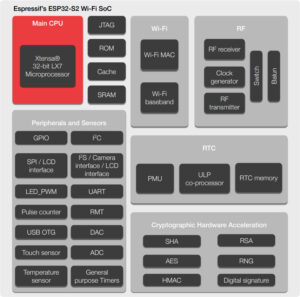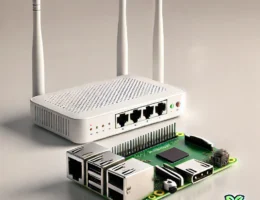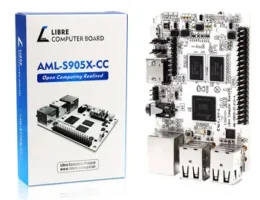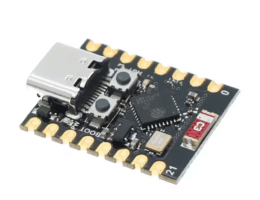Espressif announced recently that the mass production for the new ESP32-S2 will start in February 2020. Compared to the well known ESP32, ESP32-S2 brings some advantages in terms of power consumption and performance, but it lacks some important hardware features like Bluetooth or dual-core CPU.
Espressif also announced that in 2020 is planning to launch 4 new chips to cover different segments of the market. There is not much information about these, but it’s nice to see the effort this company puts into becoming a leader in IoT chips manufacturing.
ESP32-S2 overview
ESP32-S2 is designed to be a low power WiFi SoC solution for IoT and smart-home devices. It comes with enhanced encryption capabilities and improved radio performance.

While limiting the connectivity features (WiFi only, no bluetooth support), Espressif was able to add a bunch of extra peripherals for human-machine interaction like builtin camera and LCD interfaces. These will be much needed for the development of wide range of applications, from smart-home devices to industrial automation.
Processor and memory
ESP32-S2 comes with a 240 MHz Xtensa® 32-bit LX7 single-core processor with 320 KB of SRAM and 128 KB of ROM. The performance of this CPU should be similar with the one of the ESP32, but much more energy efficient.
| Feature | ESP32 | ESP32-S2 |
|---|---|---|
| CPU | Xtensa® 32-bit LX6 | Xtensa® 32-bit LX7 |
| Cores | 2 | 1 |
| Frequency | 240 MHz | 240MHz |
| ROM memory | 448 KB | 128 KB |
| SRAM memory | 520 KB | 320 KB |
| RTC SRAM memory | 8 KB | 8 KB |
| eFuse memory | 1 Kbit | 4 Kbit |
Power consumption
ESP32-S2 is much more energy efficient than ESP32, in both CPU power consumption as well as RF power consumption. In some cases, ESP32-S2 is more than 50% more efficient than ESP32. However, the peak RF power consumption of ESP32-S2 is still unsuited to run on normal batteries. The peak RF usage is way above of what a normal battery pack can handle.
| Work mode | Testing condition | ESP32 | ESP32-S2 |
|---|---|---|---|
| Modem-sleep (CPU is ON) | 240 MHz | 30 mA ~ 68 mA | 19 mA |
| 160 MHz | 27 mA ~ 44 mA | 16 mA | |
| 80 MHz | 20 mA ~ 31 mA | 12 mA | |
| Light-sleep | 800 μA | 450 μA | |
| Deep-sleep | ULP is ON | 150 μA | 220 μA |
| ULP sensor-monitored pattern | 100 μA | 7 μA | |
| RTC timer + memory | 10 μA | 10 μA | |
| RTC timer only | 5 μA | 5 μA | |
| Power off | 0.1 μA | 0.1 μA | |
| RF working | TX, 802.11b/g/n @ 19.5 dBm | 190~240 mA | 135~190 mA avg, 200~310 mA peak |
| TX, 802.11n @ 13 dBm | 180 mA | 120 mA avg, 160 mA peak | |
| RX, 802.11b/g/n | 95~100 mA | 68 mA |
Radio capabilities
ESP32-S2 promises an improved and more stable WiFi connection compared to ESP32. The new Time of Flight feature gives the possibility to calculate the distance between devices. On the downside, ESP32-S2 comes without bluetooth support, reducing the types of application this can be used for.
| ESP32 | ESP32-S2 | |
|---|---|---|
| WiFi | 802.11b/g/n | 802.11b/g/n |
| Data rate | up to 150 Mbps | up to 150 Mbps |
| ESP-MESH | Supported | Supported |
| Fine Time Measurement / Time of Flight | N/A | Supported |
| Bluetooth | v4.2 + BLE | N/A |
Peripherals and sensors
The most important difference between the two chips is the addition of the USB, LCD and Camera interfaces for the ESP32-S2. These new interfaces will allow makers to video streaming applications or user interactive devices. Also, S2 supports more cryptographic accelerators, making it suitable for secure applications.
| Feature | ESP32 | ESP32-S2 |
|---|---|---|
| GPIO | 34 | 43 |
| ADC | 2 x 12-bit, 18 channels | 2 x 12-bit, 20 channels |
| Hall sensor | Yes | No |
| DAC | 8-bit, 2 channels | 8-bit, 2 channels |
| Temperature sensor | No | Yes (-20ºC to 110ºC) |
| Touch sensor | 10 | 14 |
| Ultra-Low-Power Co-processor | Yes | Yes |
| LCD interface | No | 8-bit serial RGB |
| Camera interface | No | 8/16-bit DVP |
| USB | No | USB 1.1 OTG |
| Ethernet MAC interface | Yes | No |
| SDIO/SPI controller | Yes | Yes |
| UART | 3 | 2 |
| I²C | 2 | 2 |
| I²S | 2 | 1 |
| Infrared controller | 8 channels | 4 channels |
| Pulse counter | 8 channels | 4 channels |
| LED PWM | 16 channels | 8 channels |
| SPI | 3 | 4 |
| Accelerator | AES,SHA,RSA,ECC | AES, ECB/CBC/OFB/CFB/CTR, GCM, RSA, ECC |
ESP32 vs ESP32-S2 conclusions
With ESP32-S2, Espressif is focusing on the smart home devices market by providing improved RF and security, as well as more human-interaction peripherals. The lack of bluetooth, however, might limit the applications range of this chip, especially for amateur makers.
Do you need to upgrade your ESP32 with ESP32-S3? Well, unless you are planning to use the new peripherals, like the LCD or the Camera interface, then the ESP32-S2 won’t give you many other advantages. The price for ESP32-S2 will probably be higher than the old ESP32.




What about CAN?